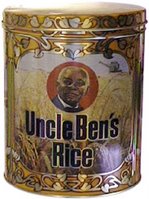
From Adweek.com…
----------------------------------
Barbara Lippert’s Critique: Uncle Ben’s Problem
By Barbara Lippert
Lately, just like real celebrities, many of our beloved ad icons have been forced into rehab.
Orville Redenbacher, who passed away in 1995, was reanimated for advertising thanks to some digital magic. The resulting resurrection is a horror show, made even creepier because we knew him as a living, breathing human being.
Last week, in a non-digitally imposed action, and after retiring the actor some time back, Maytag selected a new repairman from thousands of applicants clamoring to wear the hat. (This time the company might give him something to do.)
Fictional cooking doyenne Betty Crocker is a perennial; she gets a makeover every decade or so. In the ‘80s, General Mills turned her into a corporate executive and as such she’s gone from looking like Betty Ford to channeling Laura Bush. (Not a stretch, if you think about it.)
Obviously, advertisers want to keep the characters alive to cash in on all that brand equity. But why do consumers get so attached? My theory is that we first come into contact with these icons in childhood kitchens, and when we hold the boxes in our hands they loom large. (I thought my mother was the bonneted lady on the Sun-Maid raisins box.) They remain in our hearts and brains to an irrational degree ever after.
Then there’s Uncle Ben of Uncle Ben’s rice fame. He first appeared on rice boxes in the mid-1940s, 80 years after the Civil War. The name came from an actual African-American rice farmer known for the excellence of his crop, and suggests a holdover from slave and then segregated days in the South, when elderly black men were denied the honorific “Mr.” and instead were called “Uncle.” And then there’s the beaming image: the portrait was based on an African-American maitre d’ at a hotel in Chicago in the 1940s, and the bow tie suggests an old-time butler or porter—a person in a position of deference.
Similarly, Aunt Jemima, developed in the 1880s, was a racist “Mammy” stereotype. But she was quietly updated by removing the head wrap, subtracting substantial poundage and adding pearls. But at this moment in our truculent interactive culture, nothing is done quietly. Can the corporation (unfortunately named Masterfoods) proudly reclaim the Uncle Ben character, and change and defuse the negative connotations?
Well, much as I was ready for a “What were they thinking?” cri de coeur (and kind of cringed at the earnest announcement of a “fully integrated campaign”), the reality is that so far, the Web site, at least, is innocuous.
At unclebens.com, Ben (no last name, but at least it’s not Benson) has been elevated from some sort of server to chairman of the board. Users are invited to go behind the double mahogany door for a tour of his office. A clever kitchen-timer graphic device (the kind used for rice) pops up, as we get a 360-degree look at the executive inner sanctum, complete with the doodads on his desk. Users can even fool around with the chess set on the sideboard, although each click results in a word balloon in which Ben links chess to rice.
My favorite part is Rice 101, where I learned a lot of nice rice facts (“rice is naturally sodium- and gluten-free, and hypoallergenic”; “whole grain brown rice contains the germ and bran layers, wherein lie the majority of beneficial nutrients like antioxidants, phytonutrients, vitamins and minerals”). I thought the coolest thing was the “Rice Wall of Fame,” featuring a medical-type illustration of a blown-up grain of rice. You click on a microscope and learn the names of the various parts (like “endosperm,” the actual inside of the rice grain).
There’s a tone problem with the print, however, that doesn’t seem to match Ben’s new executive role. It comes across as less CEO-ey and more throwback folksy. Combined with the original portrait, this is a bit unfortunate.
Indeed, Ben’s image is unchanged from previous incarnations (including blue jacket, bow tie and smile). It sits on a yellowish-gold background alongside his aphorisms, or many “Benisms”—which are promoted, cleverly, as “common sense ‘grains’ of wisdom about rice.” But these tend to sound less informational and more like the funny, sassy statements on the bright yellow billboard promotions ABC did a decade back.
One of Uncle Ben’s print ads declares, “Rice. Because 6 billion people can’t be wrong.” Ba-bum. They can be wrong, if they’re starving. I realize there’s a limit to the information you can put in a print ad, but why not make them more instructive or helpful?
“How about some respect for the meat-and-rice man?” another asks. I get the wordplay (on meat and potatoes), but I find it awkward, first with the asking for respect thing (even if it’s jokey), and then suggesting as it does a song-and-dance man.
By the way, there are all different kinds of CEOs, including those who fancy themselves stand-up comics, who prepare and issue one-liners. We tend to find them annoying, regardless of race.

No comments:
Post a Comment